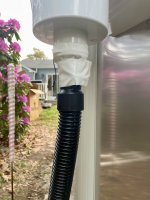Hi all, first post here but have been lurking for a few months now! Apologies in advance if I get the names of anything wrong.
I just had family over this past weekend to put up my new ABG pool. We were pretty successful up until I had a local water delivery place here to fill last night (our water/sewer bills are insane, so this was the cheapest way to go).
Once the water got up to the filter/skimmer, we noticed leaking coming from the filter hoses. We believe that my father-in-law forgot to apply Teflon tape when installing, which might have caused the leaking (photos attached to see where the leaking is coming from). To help combat the leaking, we applied Flex-Seal tape, but we're still seeing a minimal drip (kind of worried about this choice... will I even be able to get the tape off? ).
).
I haven't started the filter yet as I'm worried the leaking may get worse if I do.
I'm considering buying skimmer/filter plugs to plug everything inside the pool so we don't lose the water we just purchased, and then taking the hoses apart, applying Teflon tape, then putting everything back together.
Does this sound like the right course of action? Is there anything else I could do?
I just had family over this past weekend to put up my new ABG pool. We were pretty successful up until I had a local water delivery place here to fill last night (our water/sewer bills are insane, so this was the cheapest way to go).
Once the water got up to the filter/skimmer, we noticed leaking coming from the filter hoses. We believe that my father-in-law forgot to apply Teflon tape when installing, which might have caused the leaking (photos attached to see where the leaking is coming from). To help combat the leaking, we applied Flex-Seal tape, but we're still seeing a minimal drip (kind of worried about this choice... will I even be able to get the tape off?
I haven't started the filter yet as I'm worried the leaking may get worse if I do.
I'm considering buying skimmer/filter plugs to plug everything inside the pool so we don't lose the water we just purchased, and then taking the hoses apart, applying Teflon tape, then putting everything back together.
Does this sound like the right course of action? Is there anything else I could do?





